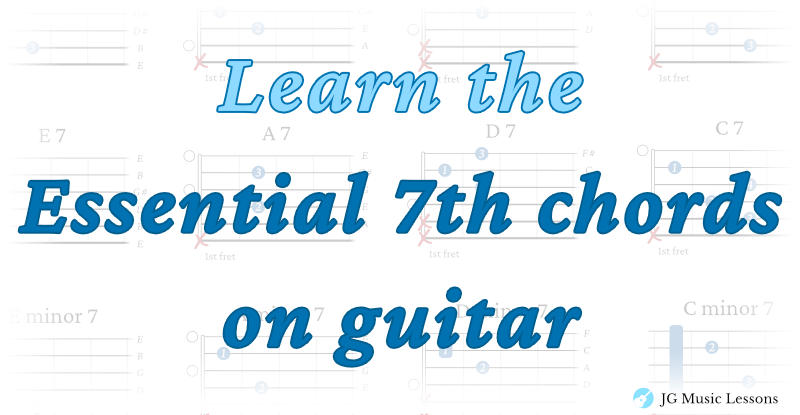Ready to level up your guitar playing? 7th chords add a rich sound to your playing which can be used across different genres such as blues, jazz, folk, and R&B.
If you’ve mastered your basic chords, learning 7th chords is a perfect way to add more depth and versatility to your playing.
This lesson covers three essential types of 7th chords which are the Major 7th, Dominant 7th, and minor 7th chord. You’ll learn how to play the 7th chord guitar shapes starting on different strings plus musical examples with audio to apply them at the end!
Grab your guitar and let’s get started!
What is a 7th chord?
A 7th chord refers to the chord tones that belong to a chord, which in their basic form would include the root note, 3rd, 5th, and 7th degree. In contrast to triad chords which contain three notes, 7th chords include the 7th degree to add more flavor and depth to the sound of a chord.
We’ll briefly go over some music theory for each chord quality to give you a better understanding of how 7th chords work.
Grab your guitar and let’s get started!
7th chords theory
Major 7 chord formula
Again, the numbers 1, 3, 5, and 7 refer to the chord tones in each chord. You will also see the distance between each of the chord tones in steps. A half step equals the distance from one fret to the next on one string and a whole step equals the distance of two frets apart on one string.
Here is the chord structure formula for Major 7 chords:

Here are some Major 7 chord examples and what notes they include:
- C Major 7 has the notes C, E, G, and B.
- E Major 7 has the notes E, G#, B, and D#.
- G Major 7 has the notes G, B, D, and F#.
As a side note, another chord that is closely related to the Major 7 is the Major 6 chord which has the chord tones 1, 3, 5, and 6. See this other lesson on how to play Major 6 chords on guitar.
Dominant 7 chord formula
This next structure simply lowers the 7th degree a half step below. The little ‘b’ represents that a note is flattened or lowered by a half step.

Dominant chords are written by simply adding a 7 next to the root note such as G 7, B 7, or D 7.
Here are some Dominant 7 chord examples and what notes they include:
- C 7 has the notes C, E, G, and Bb.
- E 7 has the notes E, G#, B, and D.
- G 7 has the notes G, B, D, and F.
Minor 7 chord formula
This next structure now lowers the 3rd and 7th degrees a half step below.

Here are some minor 7 chord examples and what notes they include:
- C minor 7 has the notes C, Eb, G, and Bb.
- E minor 7 has the notes E, G, B, and D.
- G minor 7 has the notes G, Bb, D, and F.
How to read the guitar chord charts
For the charts below:
- The lowest horizontal line represents the thickest string (Low E). The top horizontal line represents the thinnest string (high E).
- The vertical lines represent the frets on the guitar (thin metal lines on your guitar fretboard)
- The numbers inside the circles tell you what fingers to use to press down on your fretting hand (see the fingering chart in the following section)
Take a look at the image below to better understand the chord charts in this lesson.
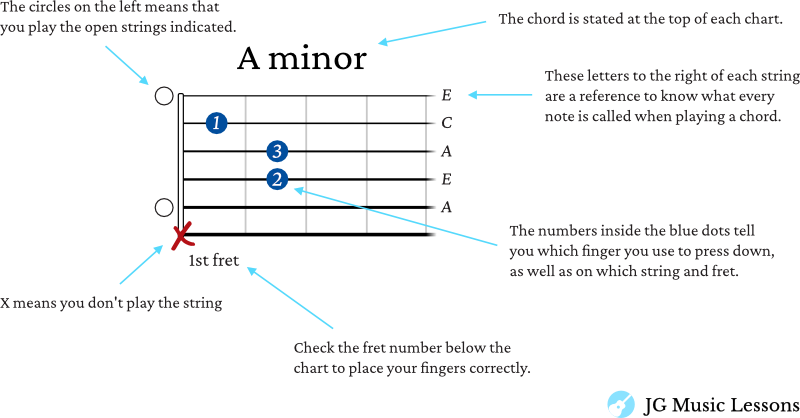
Major 7th chords
Now that we covered the theory of how these 7th chords are built, let’s start playing them!
Note that the following charts are just one way to play each chord. You can use the links below each chord chart to learn other ways of playing the same chord. At the end, we’ll have another section that shows you the movable shapes starting on different strings.
C Major 7
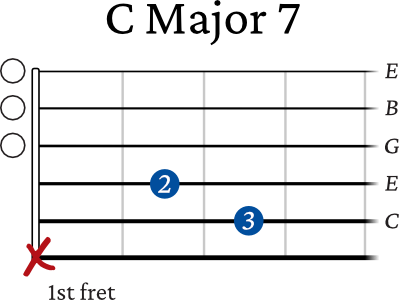
7 ways to play a C Major 7 chord on guitar
D Major 7
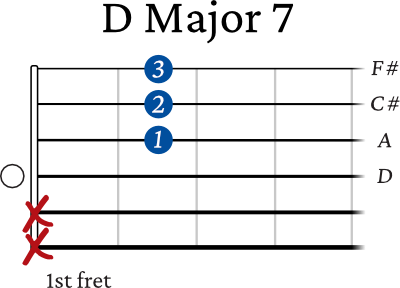
8 ways to play a D Major 7 chord on guitar
E Major 7
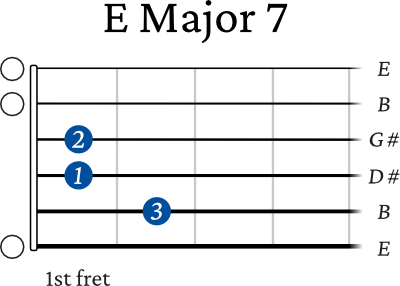
8 ways to play an E Major 7 chord on guitar
F Major 7
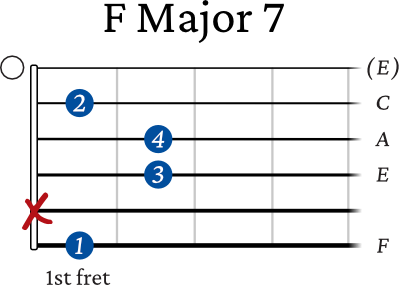
8 ways to play an F Major 7 chord on guitar
G Major 7
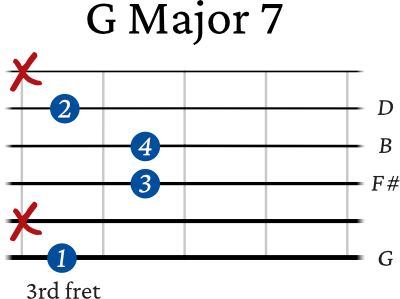
8 ways to play a G Major 7 chord on guitar
A Major 7
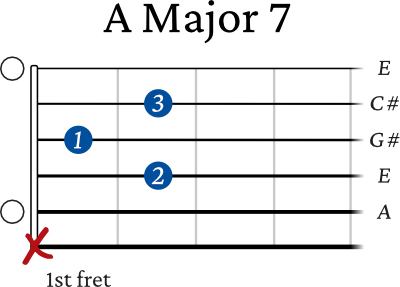
8 ways to play an A Major 7 chord on guitar
B Major 7
Note that the note on the 1st string in parenthesis is optional which means you don’t necessarily have to barre this chord if you aren’t able to yet.
If needed, see this lesson on how to get better at barre chords.
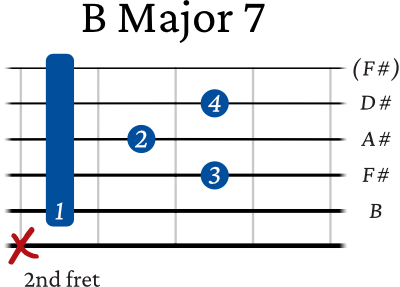
7 ways to play a B Major 7 chord on guitar
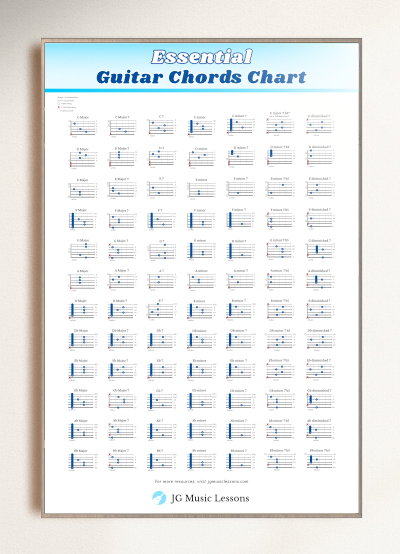
Dominant 7th chords
C 7
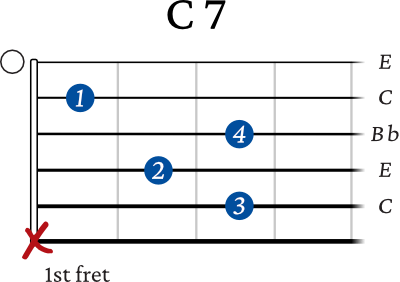
7 ways to play a C 7 chord on guitar
D 7
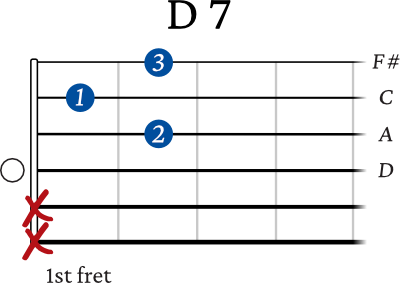
7 ways to play a D 7 chord on guitar
E 7
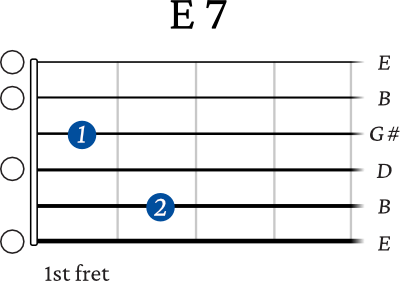
11 ways to play an E 7 chord on guitar
F 7

10 ways to play an F 7 chord on guitar
G 7

10 ways to play a G 7 chord on guitar
A 7
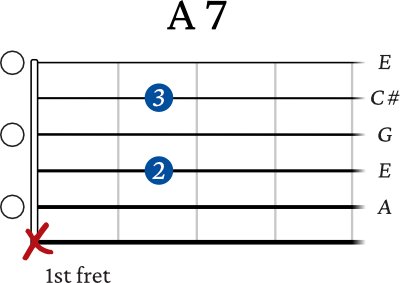
9 ways to play an A 7 chord on guitar
B 7
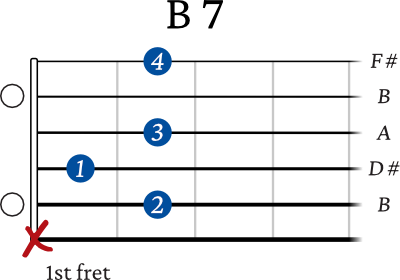
7 ways to play a B 7 chord on guitar
Minor 7th chords
C minor 7
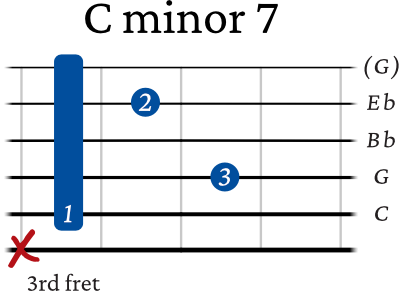
8 ways to play a C minor 7 chord on guitar
D minor 7
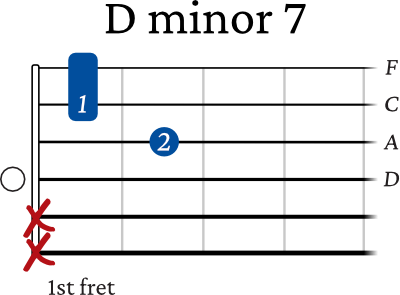
8 ways to play a D minor 7 chord on guitar
E minor 7
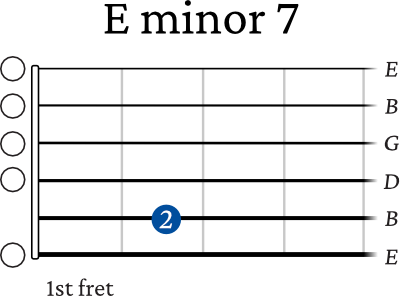
11 ways to play an E minor 7 chord on guitar
F minor 7

8 ways to play an F minor 7 chord on guitar
G minor 7

8 ways to play a G minor 7 chord on guitar
A minor 7
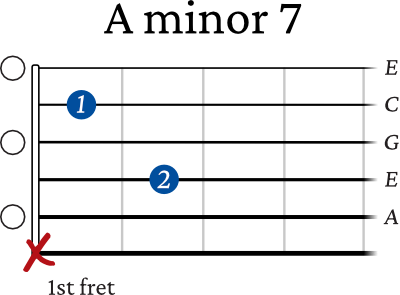
11 ways to play an A minor 7 chord on guitar
B minor 7
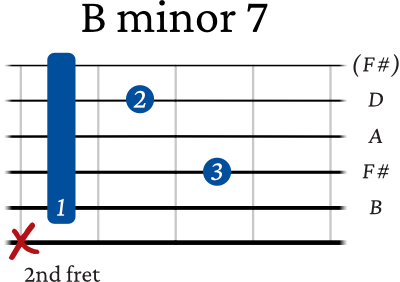
8 ways to play a B minor 7 chord on guitar
Movable 7th chords
If you’re wondering how to play other chords that include sharp or flats, we can use movable 7th chord shapes to do that.
You can shift these chord shapes to start on any root note for a particular string. In all these shapes, the lowest note would be the root note. If needed, learn the notes on the fretboard to shift these chords correctly.
Let’s start looking at the movable 7th chord shapes starting on different strings.
Movable 7th chords starting on the 6th string
The numbers on the right of the charts tell you what chord tone. Notes that have a parenthesis indicate that they are optional.
You can use these shapes to play different chords throughout the 6th string. For example, if A is your root note, make sure that your lowest note is on the 6th string, 5th fret.
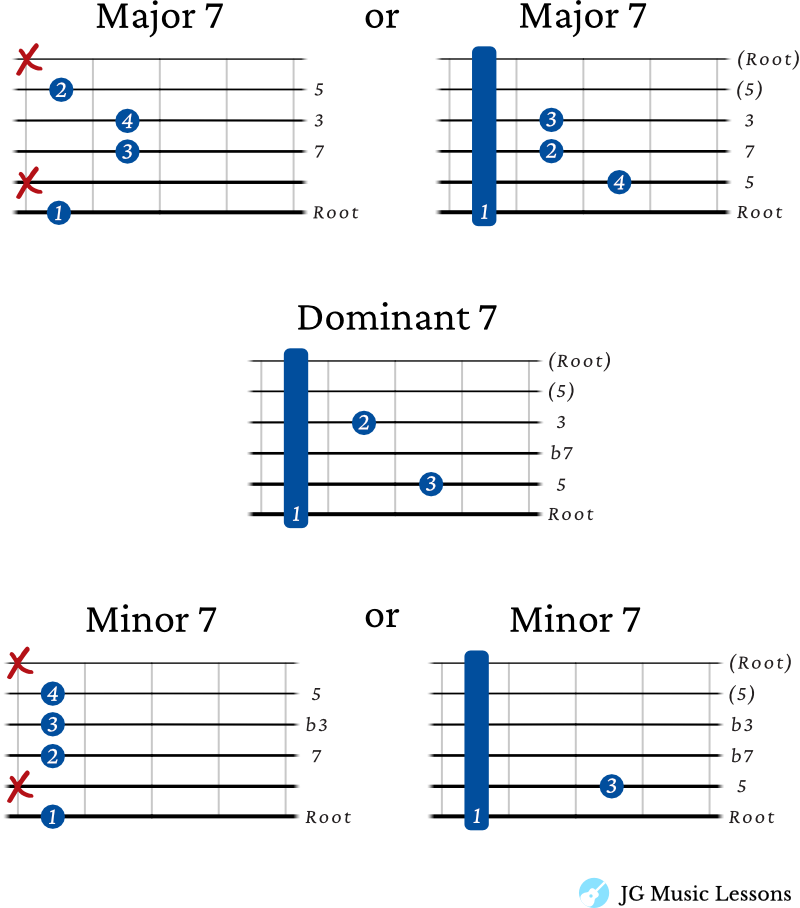
Movable 7th chords starting on the 5th string
You can use these shapes to play different chords throughout the 5th string. For example, if D is your root note, make sure that your lowest note is on the 5th string, 5th fret.
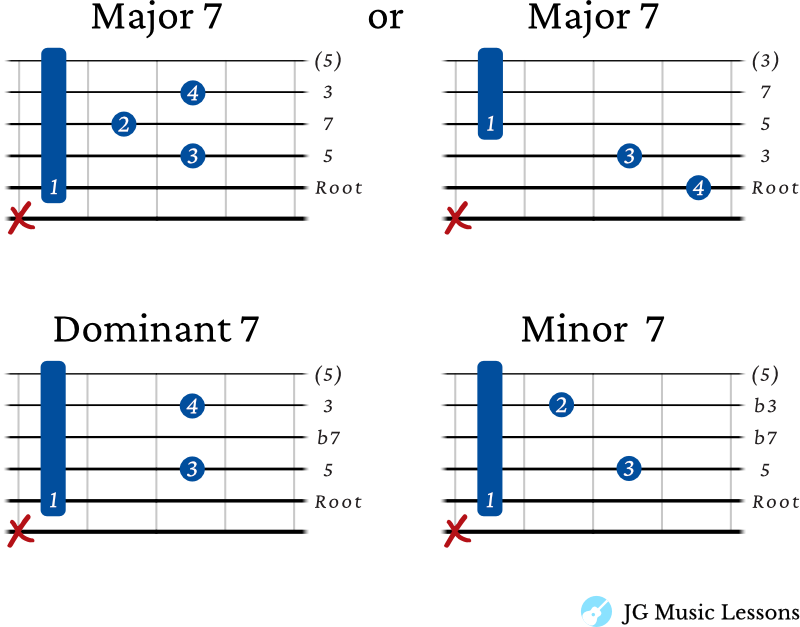
Movable 7th chords starting on the 4th string
You can use these shapes to play different chords throughout the 4th string. For example, if G is your root note, make sure that your lowest note is on the 4th string, 5th fret.
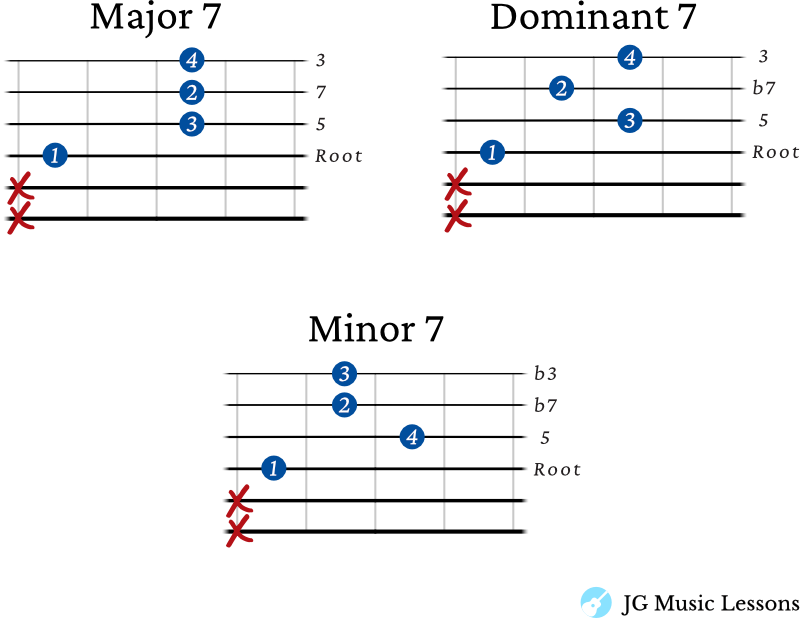
Chords progression examples using 7th chords
Feel free to use whatever rhythm or strumming pattern you like for these chord progressions. The main point is to hear what these 7th chords sound like together in a sequence. You will see an audio example for each of these four progressions.
7th chord progression example 1
Click the chords with links to learn other ways of playing that chord. Progression 1 chords are D minor 7, G 7, C Major 7, and F Major 7.

7th chord progression example 2
Progression 2 chords are A Major 7, F# minor 7, E minor 7, and D Major 7.

7th chord progression example 3
Progression 3 chords are F Major 7, E 7, A minor 7, and C 7.

7th chord progression example 4
Progression 4 chords are D Major 7, C# minor 7, and B minor 7.

(On the audio, I play the last chord on beat 4 the first time and on beat 3 the second time).
7th chord progression example 5
Progression 4 chords are G minor 7, C 7, A minor 7, and D 7.

7th chord progression example 6
Progression 6 chords are Gb Major 7, A Major 7, D Major 7, and B Major 7.

Other 7th chords: Diminished chords
Another 7th chord that we didn’t cover here is the minor 7 b5 (aka half diminished chord) which you can learn here.
The other one is the fully diminished 7 chord which has a unique sound and function in music. You can check out the lesson on how to play diminished chords on guitar here. It includes guitar charts and audio examples to better help you understand these chords.
Wrapping up
As you review these chords, you’ll get more comfortable using them in chord progressions and substituting them with basic chords you already know. These chords will help you expand your palette of sounds so that you can learn more songs or use them to create your music.
Learning your 7th chords also gives you a solid foundation to be able to build extended chords on guitar.
If you want to be able to improvise over 7th chords, a good place to start is by learning chord arpeggios which highlight important notes. You can check out how to play Major 7 arpeggios, Dominant 7 arpeggios, minor 7 arpeggios, or half diminished arpeggios on guitar.
📘 Get the free guitar practice guide here!
All the best,
JG Music Lessons
📙 Kickstart your guitar playing with our step by step guide: Guitar Essentials.
🎸 Looking for a travel or half-sized guitar? See this one.
🛠 See our other music recommendations.
🤝 Support the site to help us to create better content for you!
Level up with the FREE guitar practice guide and effectively improve your playing! 🎸
Get it sent to your email!

